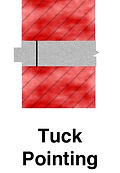Different types of pointing
What type of pointing is best for your property? There are many different types of pointing throughout Oxfordshire and we can ensure a perfect match to your existing property.
Pointing techniques
There are eight different types of pointing all with distinct advantages
Weatherd
Weathered or struck pointing is characterized by slightly recessing the mortar joint from the brick face and creating a sloped profile. This technique provides better protection against water penetration by directing moisture away from the joint. Weathered pointing adds depth and dimension to the brickwork, giving it a classic and timeless look often found in traditional or historical buildings.
Flush
In the flush pointing, the mortar filled and pressed into a mortar joint. After that, it is finished off flush with the edges of the bricks or stones, to give a smooth appearance. Then the final finish is given by trimming the edges neatly with a trowel and a straight edge.
Struck
In this pointing, the mortar is first filled and pressed to match the face of brick masonry work and then the top edge of the joint is pressed inside around 10 mm compared to the bottom edge where it will form a slope from top to bottom so that that rain will drain off quickly.
Recessed Pointing
This type of pointing is generally not suitable for buildings in exposed situations because they do not readily shed water. Recessed pointings are by pressing mortar back from edges by 5 mm or more. The pressed pointing face is kept vertical and it is advisable to use only bricks with excellent frost resistance with recessed joints but it gives a good appearance.
Tuck
In this pointing the mortar joint is filled and pressed to the level surface of masonry.
While the mortar is still fresh, grooves are cut in the mortar joint. The slot size of 5mm in width and 3mm in depth is then filled with white cement putty and kept projecting beyond the face of the joint by 3 mm.
Beaded
In Beaded Pointing the mortar is pressed into the joint and concave grooves are formed by using a steel tool having a concave shape. Beaded pointing gives an excellent appearance to the mortar joint but is liable to get damaged quickly.
Keyed
In this type mortar is first pressed into joints and a semi-circular curve-type notch is formed by a tool or small steel bar. These types of points provide an excellent appearance to the wall but are mostly used for superior-type work, particularly for vertical joints of walls.
V Groved
V pointing is similar to keyed pointing work but after the mortar has been pressed into the joint a V-shaped groove is formed in the joint by the use of V shape tool.







